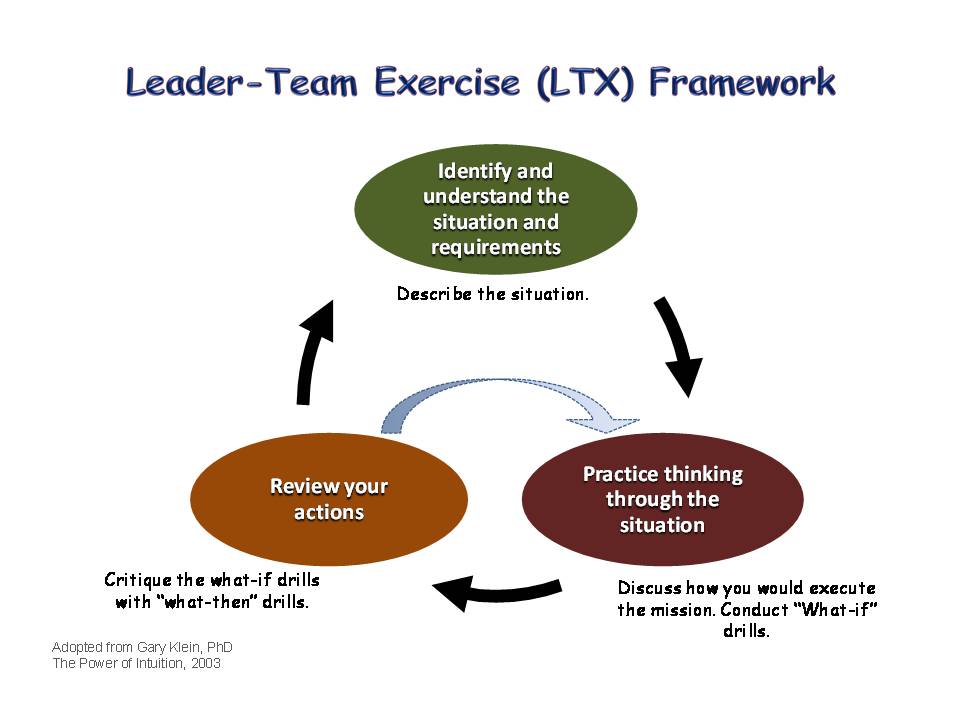Mar.21.2009
by Ed Beakley
3. The Leader-Team Exercise
 EUCOM Team of Leaders Coaching Guide (Excerpt )
EUCOM Team of Leaders Coaching Guide (Excerpt )
United States European Command, Stuttgart, Germany
Col. Charles Burnett, Director Battle Command Knowledge Systems, Ft Leavenworth, KS
Dr. Michael Prevou, Contributing Editor, Ft Leavenworth, KS
The Team of Leaders (TOL) approach is different than how teams are trained today
This approach facilitates rapid leader-team building by providing specific questions and issues to consider at each stage of a team’s lifecycle and in the context of the operational mission. These questions help develop mental models of the leader-team’s missions/requirements, concerns, and possible actions. No stepping away from the real world to “conduct an exercise.” Each LTX discussed in this approach is in context and contributes to mission outcomes.
The leader-team discussions, stimulated by the questions and considerations, accelerate shared understanding and set conditions to develop the four key qualities for a high-performing leader-team: shared team vision/purpose, shared trust, shared competency, and shared confidence.
Developing these qualities in combination with artfully applying IM tools and effective KM processes help a leader-team communicate across time and distance virtually and collaborate more effectively. The result is a leader-team that can observe, orient, decide, and act (OODA) faster than the way we work today. The ToL objective is to build leader-teams that can “connect the dots” ahead of others to influence outcomes across boundaries of organization, function, level, or culture.
The LTX is not a course or standalone set of exercises, although it could initially be introduced that way. The LTX is more a way of thinking and acting in diverse teaming situations and is most effectively applied through a coach; preferably one of the leader-team members or team leaders well versed in the approach. An external coach could and should be used in high payoff leader-teams to both model the approach and teach others as part of normal team operations.
The Leader-Team Exercise
The LTX is not a course or standalone set of exercises, although it could initially be introduced that way. The LTX is more a way of thinking and acting in diverse teaming situations and is most effectively applied through a coach; preferably one of the leader-team members or team leaders well versed in the approach. An external coach could and should be used in high payoff leader-teams to both model the approach and teach others as part of normal team operations.
The LTX is the “driver” that propels and accelerates the team of leaders though the natural team development stages, helping it achieve high-performance, exhibiting actionable understanding more quickly. The LTX should be conducted in an operational setting as a way to think through a situation and build the actionable understanding discussed above.
The art of building high-performing leader-teams is sensing what combination of practices and expectations to stimulate when and with whom to generate the intensive collaboration that fosters development of the skills, knowledge, and attitudes (SKA) that are characteristic of high-performing teams of leaders (shared trust, vision/mission, competence, confidence).
The LTX process comprises three steps. Team SKA develops primarily through the team, as a group, discussing short vignettes (situations in story form), analyzing the mission/task “what if…,” and developing options and considering the “what then…”. The three steps are as shown: 
To develop such high-performing leader-teams requires an approach that goes beyond traditional “train to task” models. Rather, these exercises develop the “art” of adaptive thinking and learning. This advanced methodology develops clear and shared understanding, critical-thinking and reasoning skills, and promotes adaptive behaviors, not conditioned responses.
The leader-team exercise, done in the context of the current mission and situation, results in an accelerated maturation of the four shared qualities: vision, trust, competence, and confidence. They help the team develop understanding with respect to the purpose, situation, conditions, and decisions as well as how to work around obstacles together.
These mental exercises apply available IM and KM enablers and improve the leader-team’s ability to effectively communicate and collaborate across organizational boundaries, time zones, and cultures. Using the technique of facilitated discussion, leader-team members gain shared insights by accelerating a process that normally transpires over a long period of time and becomes evident through real world interactions.
By varying the situations and techniques, you help maintain participant interest and deepen understanding. Initially, keep the situations simple. Focus on areas in which the entire leader-team can agree, then as shared understanding, trust, and confidence build, you can create more difficult “what if” situations.
The ToL LTX concept is a flexible, informal leader-team development tool that:
- You can use at any time.
- Lasts only a few minutes or longer as time permits.
- Uses pre-developed scenarios/vignettes/stories as well as those generated by the team of leaders.
- You can carry out in leader-team discussions, virtually or collocated.
- Any team member or the leader-team as a whole can initiate.
- Improves the way we look at and share “workarounds” to solve problems.
- Helps develop and advantage the direct and indirect rolodex (address book) contacts we all have. The broader the experiences, the greater the shared address book.
